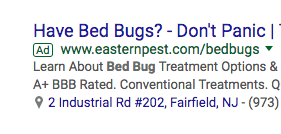How to Write a Headline for Your PPC Ad
INTRODUCTION
Writing headlines for your PPC ads is almost of equal importance to selecting the right image. While the eye is drawn first to visual, it’s a close second to the headline copy — your marketing pitch. If the image is the inducement, the copy is the transaction. Even the most captivating images will not shirk viewers away from the headline. And, with only 25 characters available and an average 3 second viewer attention span, a poorly written headline is not an option.
There are 4 pillars of writing headlines that one should stand by:
Tact, Empathy, Credibility and Impartiality.
TACT
We can go on for pages regarding how important credibility and empathy are in constructing headlines that guarantee clicks, but really it comes down to analytics. Knowing which keywords to select that will generate the most traffic, effectively out competing others, is essential in your PPC campaign.
Use Related Keywords Only
When it comes to selecting keywords, you would be amazed by how many people make the HUGE MISTAKE of listing keywords within a headline that have nothing to do with the product being sold. If you’re selling alarm clocks, for example, don’t list other appliances as keywords and expect clients to click through when they are heartily disappointed to see your ad for an “accountable alarm clock” when what they searched for was “stopwatch.”
Be Aware of Social Trends
People, by nature, want to stay on trend. Having the latest product, or knowing the most recently known service on the market, is largely what drives search queries. Be mindful of this when doing your keyword research. One idea is to tap into social media. Twitter, for example, is full of buzzwords that may allude to plausible keywords to be used in your PPC ads.

EMPATHY
Address the users problems directly.
The less steps that the reader needs to take to solve their problem, the more likely they are to click through. That’s why when crafting the perfect headlines, you should attempt to both address the client’s problem AND offer a solution, at once. In the example below, the first headlines listed is far more likely to receive a click than the second as it specifies location.

If the user were to select the second headline, they would be required to take another step in order to solve their problem. No one wants to do the extra leg work. You can have as enticing and well crafted headline as possible, but the second option, or will always win over.
Ask Questions
In order to empathize with your viewers you need to make them feel as if you know what their problem is, and only you have the solution. By asking questions, you’re not setting out to for an answer; you already know this. The real purpose of the question headline is to address the client’s issue. Inference works wonders, in this case.
In the PPC ad below, the author used a headline that implied the viewers issue, without explicitly stating it to be true. The description copy offers proof of credibility by stating that they’ve been in the business for “27 years,” while a definitive call to action is also presented within the description itself.

It wouldn’t be surprising to discover that psychologists also make excellent PPC copywriters: writing headlines is dissecting your clients train of thought in order to write the most compelling copy possible for their particular case. In the example below, the author has incited fear in order to pique interest. While this may seem forward, viewers are far less likely to click on an ad that tiptoes around the problem. Be direct, while remaining as impartial as possible.

CREDIBILITY
Grammar and Spelling
When it comes to convincing others that your product or service is as amazing as you contrive it to be, you have to ensure that your headlines are perceived as credible as possible. This doesn’t just mean having convincing content, but being as fastidious as possible with punctuation and structure. A headline that is misspelled or uses incorrect grammar is an automatic red flag for most users. After all, why should you trust them to solve your problem or offer solution if they can’t even spell a headlines correct? This should be quite self-explanatory:

Testimonials
One successful way of doing so may be to include recommendations or testimonials. If you can manage staying under the 25 character limit, including a brief quote that best captures your companies overall mission, is the best way to showcase success to your viewers, thus establishing legitimacy.
Numbers and Figures
It is only logical that people will have more faith in your business if you offer concrete evidence of its success. Making use of statistics, by listing an exact figure, causes users to be far more inclined to go with your service being offered. After all, they’ve already been given written proof that it works! See the example below:
Guarantees or Assurances
However, it pays to be mindful of promises or guarantees made. If making guarantees, ensure that you follow through on them to the T. If what you’re offering in your ad varies from what’s actually being offered, this can be severely detrimental to your business. One unhappy client can cause a domino effect of bad reviews. Avoid this by staying as fastidious as possible to what you’re presenting in your ad.
IMPARTIALITY
You cannot infer anything about your buyer. Focus only on the product being sold, rather than implying anything about the status of the prospective buyer. If you believe that there is a way to circumvent this, think again. Facebook will automatically flag ads that deter from their strict policy guidelines in order to maintain political correctness and promote an unbiased nature of their ads. For reference you can refer to them here.
Remember, write ads that market your product, with the prospective buyer’s issue in mind, rather than explicitly stating their issue.